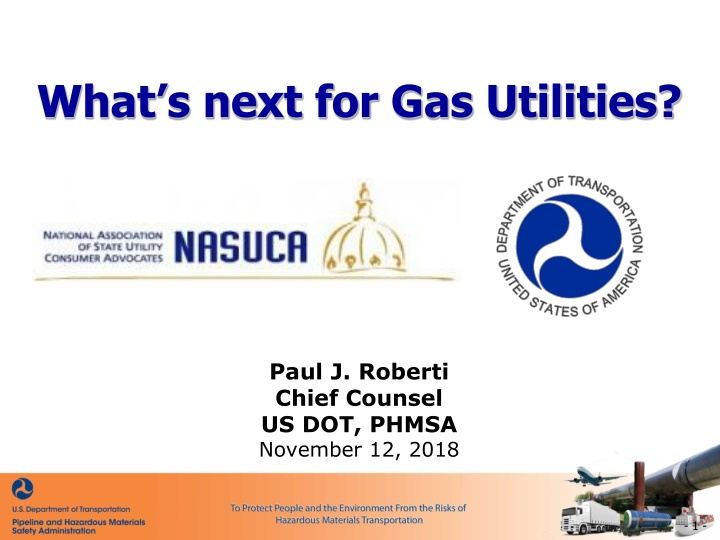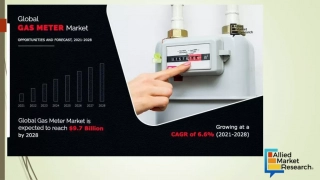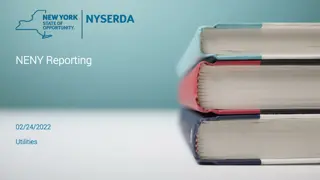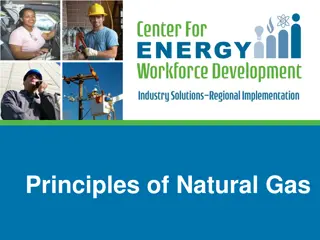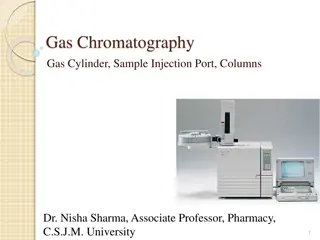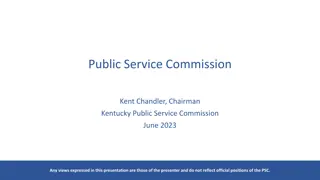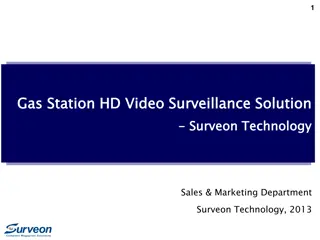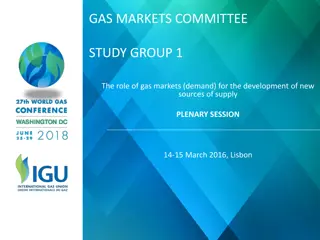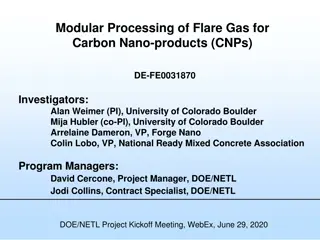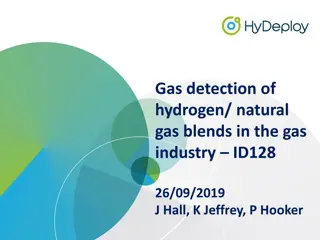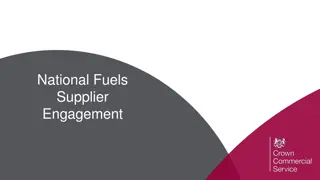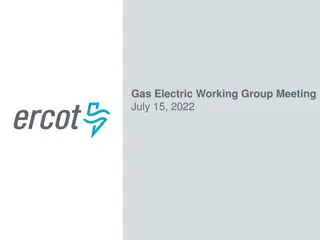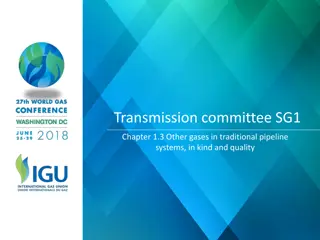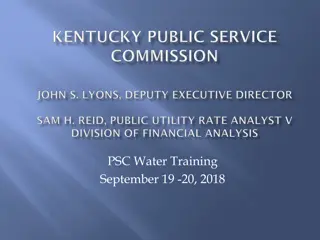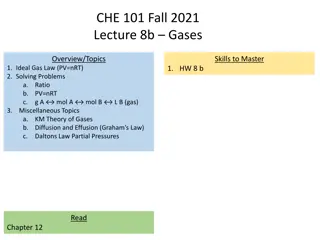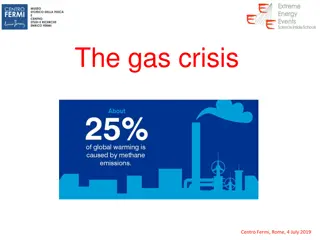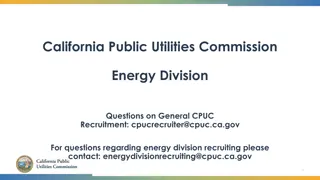Gas Utilities: Challenges and Solutions
Gas utilities face challenges with aging infrastructure, distribution line safety, and significant incidents. Explore regulatory goals, pipeline facilities, and incidents data to understand the industry's evolving landscape.
Download Presentation

Please find below an Image/Link to download the presentation.
The content on the website is provided AS IS for your information and personal use only. It may not be sold, licensed, or shared on other websites without obtaining consent from the author.If you encounter any issues during the download, it is possible that the publisher has removed the file from their server.
You are allowed to download the files provided on this website for personal or commercial use, subject to the condition that they are used lawfully. All files are the property of their respective owners.
The content on the website is provided AS IS for your information and personal use only. It may not be sold, licensed, or shared on other websites without obtaining consent from the author.
E N D
Presentation Transcript
Whats next for Gas Utilities? Paul J. Roberti Chief Counsel US DOT, PHMSA November 12, 2018 - 1 -
Distribution Lines: Balancing Costs and Safety Issues 1. Aging Infrastructure 2. Replacement of Cast Iron and Bare Steel Pipe 3. Gas Distribution Integrity Management Implementation and Continuous Improvement 4. Regulatory Goals - 2 -
PHMSA Regulated Pipeline Facilities OPS and State Partners CY 2017 Gas Distribution (Mains & Services) Total Miles: 2,235,727 Percentage miles: 80% Number of Operators: 1,362 - 3 -
Distribution Lines and Safety: Causes of Incidents and Concerns - 4 -
Gas Distribution Significant Incidents CY 2017 Leading Causes: Outside Force Damage (29%) Excavation Damage (25%) Significant Incident - an incident which causes: Fatality or injury requiring in-patient hospitalization $50,000 or more in total costs Highly volatile liquid releases of 5 barrels or more or other liquid releases of 50 barrels or more Liquid releases resulting in an unintentional fire or explosion data as-of 2-20-2018 - 5 -
Gas Distribution Significant Incidents per Million Miles (2005 2017) Rate has fluctuated since 2005 - overall decrease since 2005 is 30% Rate with evacuation has decreased 28% since 2005 Rate with public property damage has decreased 49% since 2005 Data as of: 3-28-2018 - 6 -
Aging Infrastructure - 7 -
Aging Infrastructure In 2011, PHMSA issued a Call to Action to accelerate the repair, rehabilitation, and replacement of the highest-risk pipeline infrastructure. PHMSA provides an annually-updated online inventory of high-risk pipeline infrastructure by state. Highlights efforts to replace iron and bare steel gas distribution pipelines and shows trends in pipeline miles by decade of installation. - 8 -
Gas Distribution Miles by Decade Installed (2005 2017) 30% of gas distribution systems were installed Pre-1970 Miles of pipeline system installed Pre-1970 has declined 18% since 2005 Data as of: 3-28-2018 - 9 -
Cast Iron and Bare Steel History Pipelines constructed of cast and wrought iron, as well as bare steel, are among those pipelines that pose the highest-risk. The degrading nature of iron alloys, the age of the pipelines, and pipe joints design have greatly increased the risk involved with continued use of such pipelines. Approximately 97 percent of natural gas distribution pipelines in the U.S. were made of plastic or steel at the end of 2017. The remaining 3 percent is mostly iron pipe. - 10 -
Cast Iron and Bare Steel History Cast and wrought iron pipelines were originally constructed to transport manufactured gas beginning in the 1870s and 1880s, with cast iron becoming more popular in the early 1900s. In 1970, PHMSA began collecting data about gas pipelines mileage categorized by pipe material type. In 1983, gas distribution pipeline operators reported 61,536 miles of cast iron and 4,371 miles of wrought iron pipe. Operators began submitting merged data for the two beginning in 1984. - 11 -
Gas Distribution Cast and Wrought Iron (2005 2017) Cast and Wrought Iron Main Miles have decreased 38% since 2005 Cast and Wrought Iron mains are less than 2% of the total gas distribution main miles. Cast and Wrought Iron Service Count data quality efforts are underway Less than .1% of all gas distribution services are Cast and Wrought Iron. Data as of: 11-08-2018 - 12 -
Aging Pipe Replacement The Pipeline Safety, Regulatory Certainty, and Job Creation Act of 2011 calls for DOT to conduct a state-by-state survey on the progress of cast iron pipeline replacement. Nineteen states have completely eliminated cast or wrought iron natural gas distribution lines within their borders. Replacement programs to transition to plastic piping. For updates on the states progress, contact information and incident and mileage data, the public should visit PHMSA s state pipeline profiles. - 13 -
Incident and Consequence Analysis Gas distribution incident reports (excluding those caused by leaks beyond the customer meter) for 2005 through 2017 show the following: 10.6 percent of the incidents occurring on gas distribution mains involved cast iron mains. However, only 2 percent of distribution mains are cast iron. 37 percent of the cast/wrought iron main incidents caused a fatality or injury, compared to only 20 percent of the incidents on other types of mains. 41 percent of all fatalities and 19 percent of all injuries on gas distribution mains involved cast or wrought iron pipelines. - 14 -
Gas Distribution Integrity Management Program (DIMP): Inspection Observations, Results, and Findings - 15 -
DIMP Regulations PHMSA published the final rule establishing integrity management requirements for gas distribution pipeline systems on December 4, 2009 (74 FR 63906), with an effective date of February 12, 2010 (49 CFR Part 192, Subpart P). The DIMP regulations are performance based to allow operators to implement their DIMP in the most efficient and effective manner to improve pipeline safety. Under the DIMP regulations, operators, including those with cast/wrought iron, must have knowledge of the specific characteristics of the pipe and environments where graphitization could be severe. Operators must also evaluate past leak history and monitor cast/wrought iron pipe during excavations as part of maintaining integrity. - 16 -
DIMP Implementation Operators should treat DIMP as a tool to analyze needs and progress, not as a regulatory exercise or a book on the shelf. Operators are required to know and understand their systems and the environments in which they operate. The DIMP should culminate in a ranked/prioritized list of threats, risk reduction measures being implemented to address risks, and performance measures for program effectiveness. An operator s DIMP must mature and be continuously improved to fit the unique operating environment - a continuous learning experience! - 17 -
Employee Training Concerns Inconsistent training of operator personnel regarding DIMP requirements. Lack of awareness of DIMP by all operator personnel not just at the headquarter or compliance level. Data quality is a common concern, and an appropriate level of resource allocation is required. Outdated field data acquisition forms Incomplete forms with obvious errors Data cleanup and scrubbing is often required - 18 -
Employee Retention Concerns Vacancies created by an aging workforce (turn-over) have created voids in operating knowledge of pipeline systems, and trained personnel have not always been available for inspections. Retention of trained and qualified employees has been identified as a common issue requiring transition planning and training. Documentation of a pipeline system and operation, maintenance & inspection procedures are important to retain knowledge. - 19 -
Potential Threats Must Be Considered Over pressurization events Regulator malfunction or freeze-up Cross-bores into sewer lines Materials, Equipment, Practices, etc. with performance issues Vehicular or Industrial activities Incorrect maintenance procedures or faulty components Mechanical fitting failures (Vintage Plastic and Steel) Operator error/quality of workmanship Age of system and equipment Electrical arcing onto the gas systems Other potential threats specific to the operator's unique operating environment - 20 -
An Unique Operating Environment There are many factors that affect the safe operation and integrity of pipeline system These factors are changing over time based on age, environmental changes or other factors: Increases in leakage rates based on location or pipe material or construction era Decreasing efficiency in corrosion protection systems Changes in apparent causes of leaks and hazardous leaks Data integrated from lessons learned from field personnel Etc - 21 -
Improving Safety through Performance Measures and Trending Analyses - 22 -
What gets measured, gets done. To ensure risk mitigation measures are improving safety, performance must be measured and trended. There are many websites that provide performance monitoring for Stakeholders at the national, regional, and operator level: PHMSA Data and Statistics Overview - www.phmsa.dot.gov/data-and-statistics/pipeline/data-and- statistics-overview PHMSA National Pipeline Performance Measures - www.phmsa.dot.gov/data-and-statistics/pipeline/national- pipeline-performance-measures PHMSA DIMP Website www.primis.phmsa.dot.gov/dimp/perfmeasures.htm PHMSAState Pipeline Performance Metrics - www.phmsa.dot.gov/data-and-statistics/pipeline/state- pipeline-performance-metrics - 23 -
Trends in Gas Distribution Incidents by Cause - National Data - ALL REPORTED Incident Cause Type ALL OTHER CAUSES CORROSION 2 3 1 5 2 5 EXCAVATION DAMAGE INCORRECT OPERATION MATERIAL/ WELD/EQUP FAILURE NATURAL FORCE DAMAGE OTHER OUTSIDE FORCE DAMAGE Grand Total 168 140 163 144 156 120 Total 2005 2006 2007 2008 2009 2010 2011 2012 2013 2014 2015 2016 2017 15 23 22 16 21 15 14 7 9 12 12 14 13 193 4 30 3 13 1 35 2 31 1 43 1 31 30 501 67 49 53 35 43 24 37 7 4 1 6 5 9 9 7 4 8 3 8 3 79 11 7 13 9 12 8 13 11 16 12 8 14 17 151 15 11 12 11 13 9 12 5 5 8 14 6 6 127 51 43 41 62 60 50 35 39 34 34 30 32 32 543 117 90 104 107 104 118 108 1,624 - 24 -
National Trends in Gas Distribution Leaks Leaks Eliminated Hazardous Leaks Eliminated - 25 -
Significant Gas Distribution Incidents - Nationally- Data indicates an upward trend for significant incidents over the last 8 years since DIMP regulations came into effect. - 26 -
Current Regulatory Topics for Distribution Operators - 27 -
Current Pipeline Safety Rulemakings PIPELINE SAFETY Title / Subject RIN Stage Publication Date Plastic Pipe Rule 2137- AE93 FR 09/28/2018 Underground Storage Facilities Natural Gas 2137- AF22 FR 12/21/2018 Enhanced Emergency Order Procedures 2137- AF26 FR 12/24/2018 Safety of Hazardous Liquid Pipelines 2137- AE66 FR 12/28/2018 Pipeline Safety: Gas Rule (mandates) 2137- AE72 FR 03/14/2019 Safety of Gas Gathering Pipelines 2137- AF38 FR 12/20/2019 Safety of Gas Transmission Pipelines: Discretionary IM Impr. 2137- AF39 FR 12/20/2019 Rupture Detection and Valves 2137- AF06 NPRM 01/17/2019 Liquid Pipeline Regulatory Reform 2137- AF37 NPRM 02/01/2019 Gas Pipeline Regulatory Reform Class Location Requirements 2137- AF36 2137- AF29 NPRM 05/10/2019 ANPRM 07/31/2018 Periodic Standards Update 2137- AF13 NPRM 04/20/2020 Coastal Ecological Unusually Sensitive Areas 2137- AF31 ANPRM 04/20/2020 Repair Criteria for Hazardous Liquid Pipelines 2137- AF44 NPRM TBD Amendments to Liquefied Natural Gas Facilities 2137- AF45 NPRM TBD - 28 -
Regulatory Reform Goals Provide regulatory relief from programs that do not significantly improve safety in relation to the cost to the operator. Allow operators to focus resources on heightened safety concerns. Regulatory agenda considers NTSB recommendations. - 29 -
Regulatory Reform Goals Identified potential areas of reform based on comments submitted in response to 82 FR 45750 Oct. 2, 2017) requesting comment on existing regulations that may be eligible for repeal, replacement, suspension, or modification without compromising safety. Considering comments such as: Mechanical Fitting Failure reports; Master meter requirements in DIMP; Farm tap requirements in DIMP. - 30 -
Current NTSB Investigations of Incidents in Gas Distribution Systems Minneapolis, Minnesota August 2, 2017 awaiting report https://www.ntsb.gov/investigations/AccidentReports/Pages/ DCA17MP007-prelim-report.aspx Dallas, Texas February 23, 2018 awaiting report https://www.ntsb.gov/investigations/AccidentReports/Pages/ PLD18FR002-preliminary.aspx Safety Recommendations on PermaLock Mechanical Tapping Tees issued June 18, 2018 Millersville, Pennsylvania July 2, 2017 awaiting report https://www.ntsb.gov/investigations/AccidentReports/Pages/ pipeline.aspx Response to Event in Lawrence, MA September 13, 2017 https://www.ntsb.gov/investigations/AccidentReports/Pages/ PLD18MR003-preliminary-report.aspx - awaiting report - 31 -
Lessons Learned Programs NTSB has asked - How did this happen and Why did the DIMP not identify the threat as an issue? Similar to what Congress asked in forming the Voluntary Information Sharing (VIS) Committee Why do we have so many failures following in-line inspections? VIS Committee Learning - Implementing lessons learned programs support development of a safety culture: Corrective Action Programs & Near Miss Reporting FAA Aviation Safety Alert Programs FRA - Confidential Close Call Reporting Quantitative Data Programs take longer to implement. - 32 -
Questions? - 33 -
